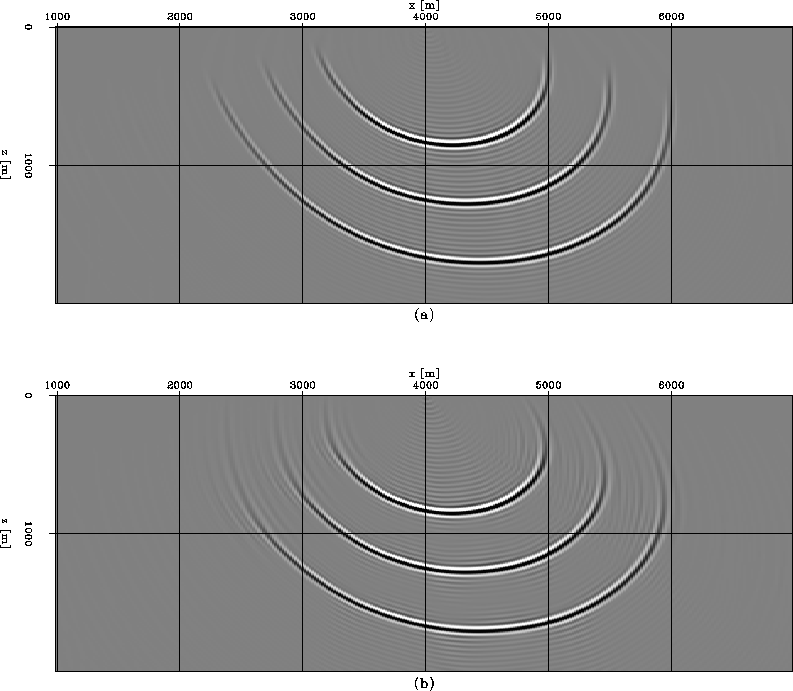




Next: 3D impulse response
Up: Numerical example
Previous: 2D impulse response
Figure ![[*]](http://sepwww.stanford.edu/latex2html/cross_ref_motif.gif) compares the 19-point filter with the new 5-point filter for the migration of an anisotropic synthetic dataset. Shan and Biondi (2005) migrate this dataset with the anisotropic plane-wave migration in tilted coordinates. Figure
compares the 19-point filter with the new 5-point filter for the migration of an anisotropic synthetic dataset. Shan and Biondi (2005) migrate this dataset with the anisotropic plane-wave migration in tilted coordinates. Figure ![[*]](http://sepwww.stanford.edu/latex2html/cross_ref_motif.gif) (a) shows the density model of this synthetic dataset. We can see the steeply dipping salt flank in the density model.
Figure
(a) shows the density model of this synthetic dataset. We can see the steeply dipping salt flank in the density model.
Figure ![[*]](http://sepwww.stanford.edu/latex2html/cross_ref_motif.gif) (b) is the anisotropic plane-wave migration in tilted coordinates with the 19-point filter.
Figure
(b) is the anisotropic plane-wave migration in tilted coordinates with the 19-point filter.
Figure ![[*]](http://sepwww.stanford.edu/latex2html/cross_ref_motif.gif) (c) is the anisotropic plane-wave migration in tilted
coordinates with the improved 5-point filter.
The migration result of the new 5-point filter is very close to the 19-point filter, though
it loses a little resolution at the salt flank. This synthetic data example shows that we can get good accuracy for
high-angle energy in tilted coordinates, though we use the improved 5-point filter, which is less accurate than
19-point filter.
oldnew
(c) is the anisotropic plane-wave migration in tilted
coordinates with the improved 5-point filter.
The migration result of the new 5-point filter is very close to the 19-point filter, though
it loses a little resolution at the salt flank. This synthetic data example shows that we can get good accuracy for
high-angle energy in tilted coordinates, though we use the improved 5-point filter, which is less accurate than
19-point filter.
oldnew
Figure 5 Comparison of the 2D impulse response of the 19-point filter and the improved 5-point filter.
(a) The impulse response of the 19-point filter. (b) The impulse response of the improved 5-point filter.










Next: 3D impulse response
Up: Numerical example
Previous: 2D impulse response
Stanford Exploration Project
5/3/2005

![[*]](http://sepwww.stanford.edu/latex2html/cross_ref_motif.gif) compares the 19-point filter with the new 5-point filter for the migration of an anisotropic synthetic dataset. Shan and Biondi (2005) migrate this dataset with the anisotropic plane-wave migration in tilted coordinates. Figure
compares the 19-point filter with the new 5-point filter for the migration of an anisotropic synthetic dataset. Shan and Biondi (2005) migrate this dataset with the anisotropic plane-wave migration in tilted coordinates. Figure ![[*]](http://sepwww.stanford.edu/latex2html/cross_ref_motif.gif) (a) shows the density model of this synthetic dataset. We can see the steeply dipping salt flank in the density model.
Figure
(a) shows the density model of this synthetic dataset. We can see the steeply dipping salt flank in the density model.
Figure ![[*]](http://sepwww.stanford.edu/latex2html/cross_ref_motif.gif) (b) is the anisotropic plane-wave migration in tilted coordinates with the 19-point filter.
Figure
(b) is the anisotropic plane-wave migration in tilted coordinates with the 19-point filter.
Figure ![[*]](http://sepwww.stanford.edu/latex2html/cross_ref_motif.gif) (c) is the anisotropic plane-wave migration in tilted
coordinates with the improved 5-point filter.
The migration result of the new 5-point filter is very close to the 19-point filter, though
it loses a little resolution at the salt flank. This synthetic data example shows that we can get good accuracy for
high-angle energy in tilted coordinates, though we use the improved 5-point filter, which is less accurate than
19-point filter.
(c) is the anisotropic plane-wave migration in tilted
coordinates with the improved 5-point filter.
The migration result of the new 5-point filter is very close to the 19-point filter, though
it loses a little resolution at the salt flank. This synthetic data example shows that we can get good accuracy for
high-angle energy in tilted coordinates, though we use the improved 5-point filter, which is less accurate than
19-point filter.
